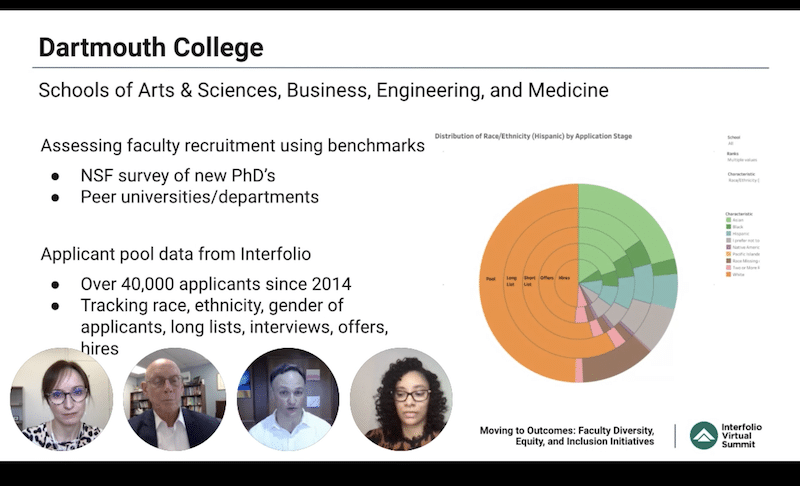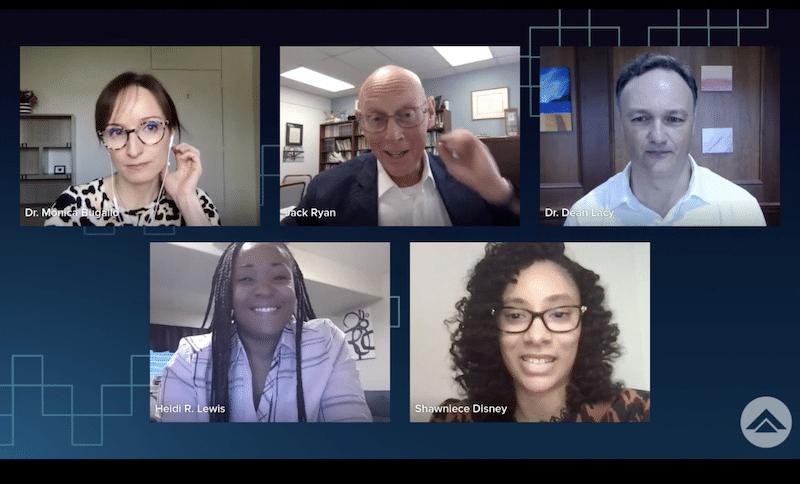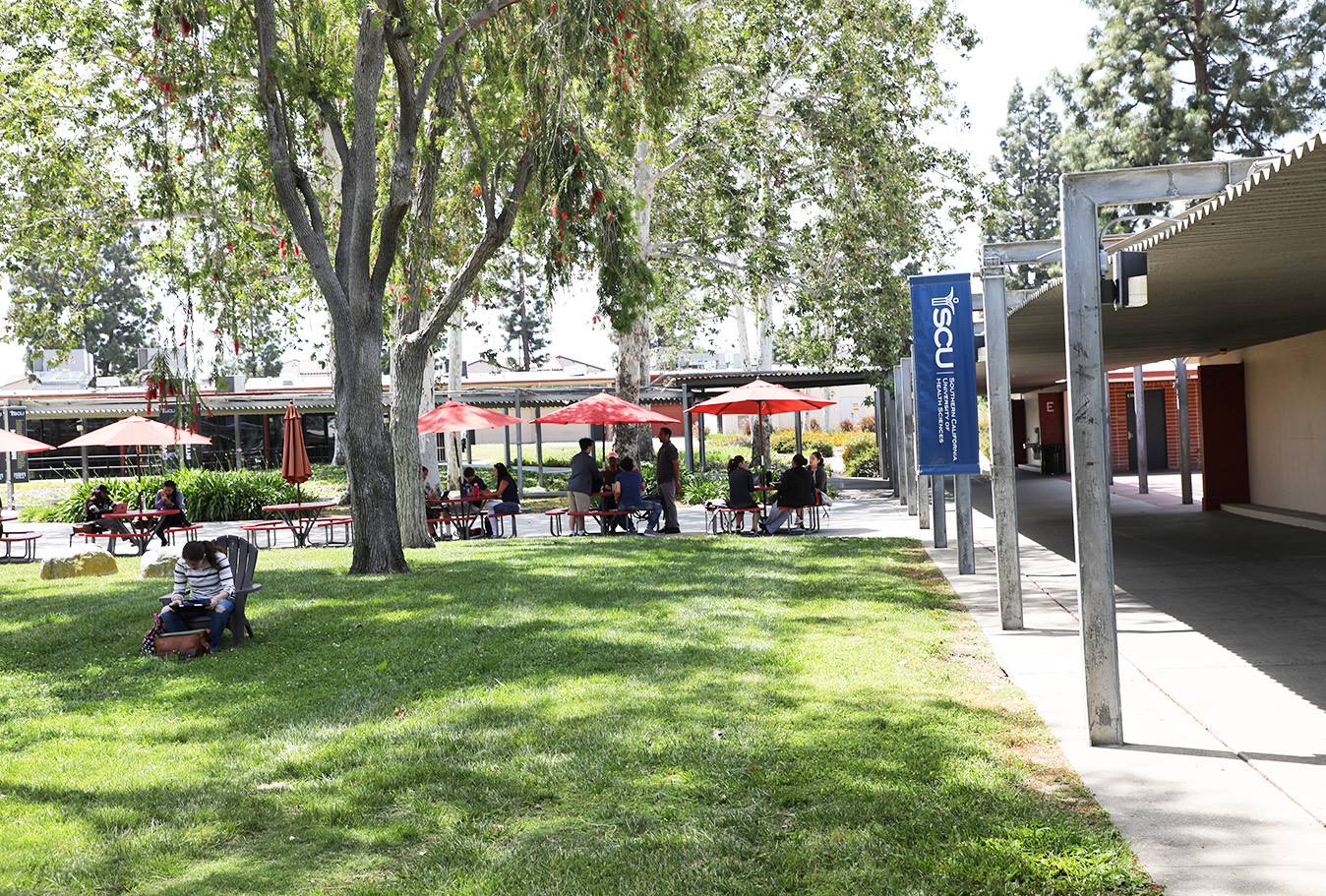Thank you, thank you, thank you to the nearly 1,000 registrants from academic and faculty affairs, technology, HR, and other university roles who made the 2021 Interfolio Summit, earlier this month, a uniquely valuable event.
Here, we’re going to share just a few of the things that made the two-day virtual conference so worth everyone’s time.
We’re going to focus on five recurring themes—feel free to hop down to what interests you the most:
- An Academic/Faculty Affairs Community of Practice
- Progress on Faculty Diversity, Equity and Inclusion
- Achieving Efficiency (with Integrity) in Faculty Affairs Personnel Processes
- Integrations: Faculty Affairs and the University Technology Ecosystem
- Successful Change Management: Real People and Faculty Affairs Technology
1. An Academic/Faculty Affairs Community of Practice
The 2021 Interfolio Summit provided a unique venue for interaction to academic/faculty affairs professionals, as well as those in university technology and HR whose work touches faculty employment.
Whether in the form of the 20 prepared sessions, the lively chat throughout, the audience Q&A, or the “Meet the Speakers” breakout rooms, the Summit this year provided a space to talk about successfully supporting faculty in the modern university.
In “Maximizing Efficiency with Creative Uses of Interfolio Review, Promotion & Tenure,” Elizabeth City State University’s Dr. Farrah Ward, Provost and Vice Chancellor for Academic Affairs and Dr. Joy Smith, Dean of the School of Education and Business showed how they have extended their use of the platform beyond academic evaluations to include faculty credentialing.
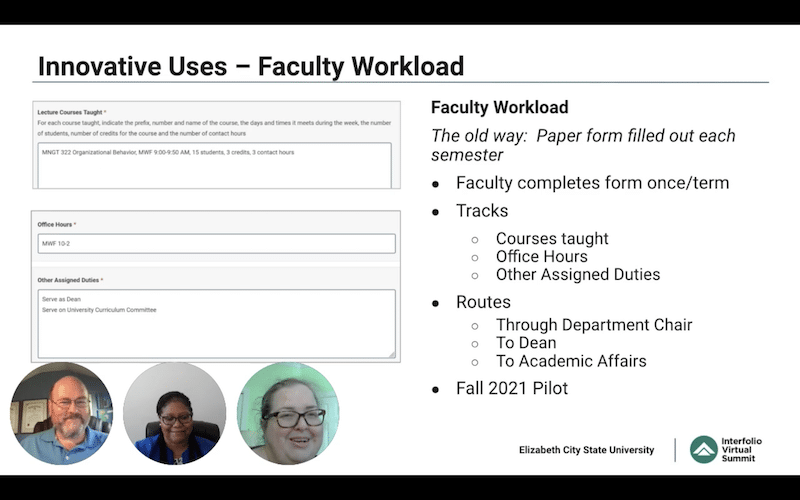
With “Documenting Personnel Processes and Increasing User Adoption,” Arizona State University’s Chantel Powers, Academic Personnel Analyst and Katherine Sackman, Academic Personnel Specialist, gave a detailed walk-through of their model for ensuring that the very practical “nuts and bolts” of their procedures are as easy as possible to locate, maintain, and carry out.
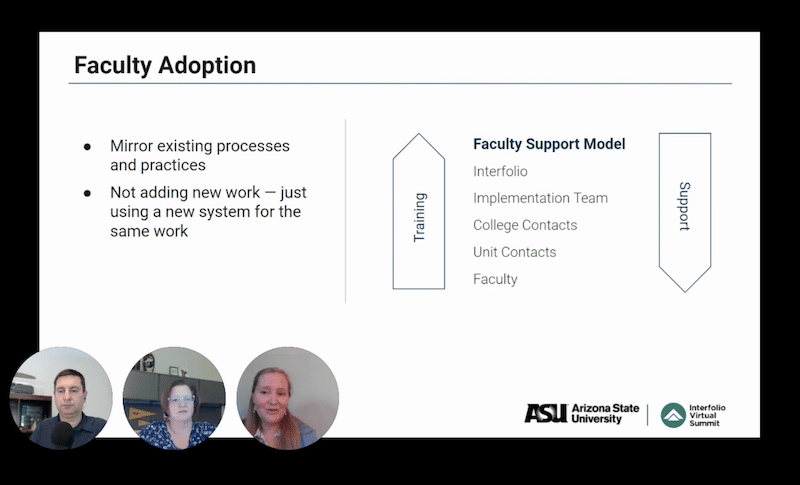
And during “Stories from the Field: Managing Interfolio Long-Term,” Lauren Wolk, Senior Consultant, and Kelly Doolan, Project Manager, from the Interfolio Professional Services team announced the Interfolio Certification program, a newly formalized course by which academic professionals can demonstrate their full competency with the Interfolio Faculty Information System.
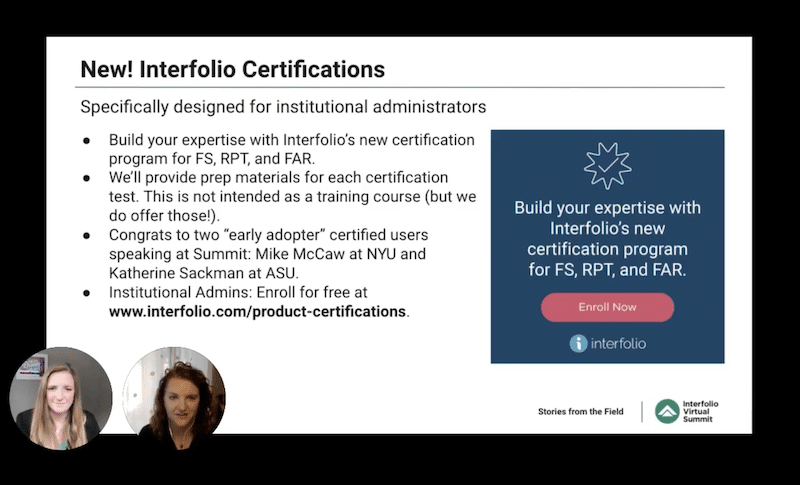
2. Progress on Faculty Diversity, Equity and Inclusion
Early in planning the Summit, Interfolio recognized that the issues of justice and equal opportunity continue to pose a pressing challenge throughout the US and global society—no less in higher education faculty affairs than anywhere else.
Right from the opening keynote address by Dr. Ebony O. McGee, Associate Professor of Diversity and STEM Education at Vanderbilt University’s Peabody College (“Beyond Recruiting: Retaining Underrepresented Minoritized Faculty & Graduate Students”) this year’s Summit included an explicit and searching focus on issues of faculty diversity, equity, and inclusion in modern higher education.
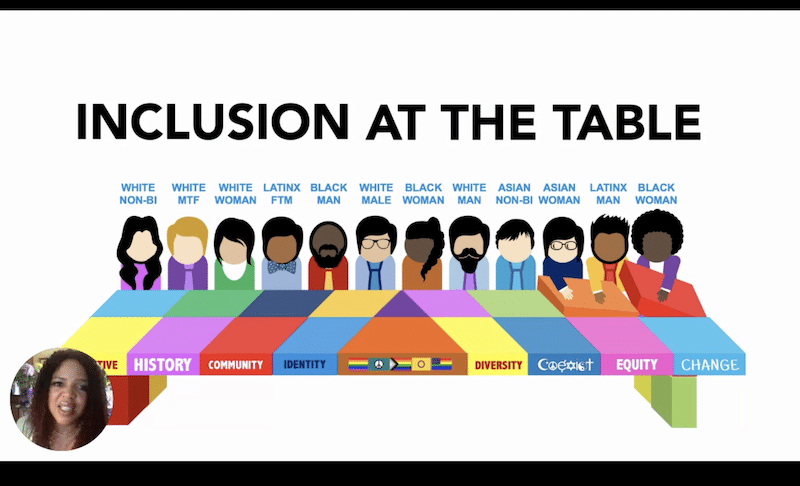
Our panel “Moving to Outcomes: Faculty Diversity, Equity, and Inclusion Initiatives” saw academic leaders from Stony Brook University, Dartmouth University, Colorado College, and the Consortium for Faculty Diversity discussing specific tactics they’ve used, as well as the outcomes.
The panel provided concrete recommendations for building lasting diversity, a truly inclusive environment, and an equitable work experience for scholars.
Among many topics not limited to diversity, equity, and inclusion, “HBCU Leaders in Conversation” offered a look into current challenges and successes of the US’s historically black colleges and universities. Attendees got to hear a lively discussion between Dr. Stashia Emanuel, Vice Provost for Academic Services at Kentucky State University, Dr. Patricia Williams-Lessane, Associate Vice President at Morgan State University, and Dr. James Palmer, Provost and Senior Vice President for Academic Affairs at Prairie View A&M University. The panel discussed specific outreach and faculty support approaches, current recruitment and retention efforts, and especially how the Interfolio Faculty Information System has directly enabled progress on their strategic plans.
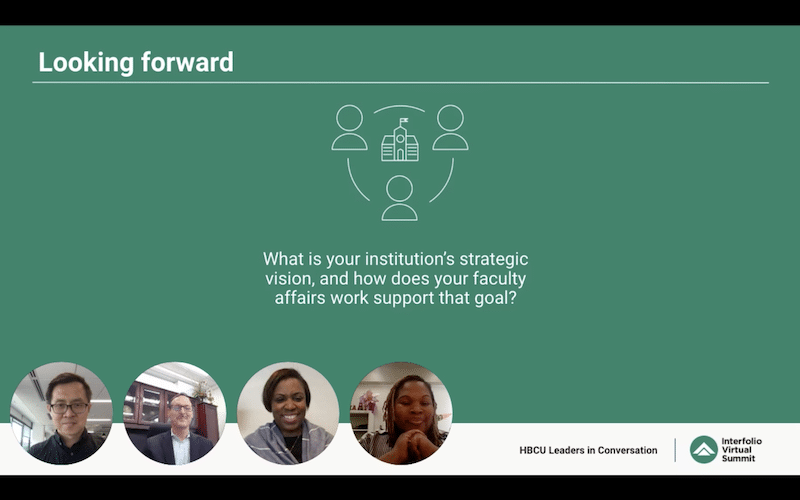
In “Streamlining Insights with Reportable Diversity, Equity, and Inclusion Activities,” Bridget Mullaney, MD, PMP of the Facet Project Team in the Office of the Provost at Emory University shared a model Emory employs to successfully track faculty members’ DEI-relevant professional activities and enable both the scholar and the institution to tell that story.
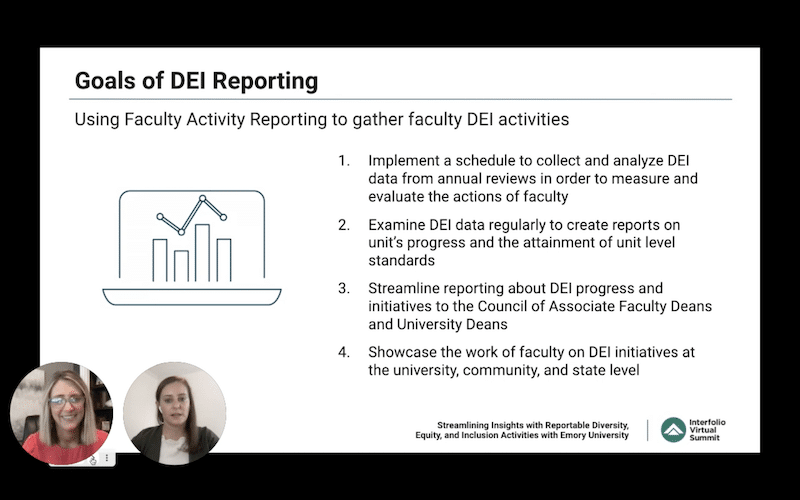
3. Achieving Efficiency with Integrity in Faculty Affairs Personnel Processes
This year’s Summit continued to showcase how higher education institutions use Interfolio to make faculty affairs processes more efficient and best use faculty, staff, and administrator time. Equally clear, however, was the commitment to maintain excellence in the personnel decisions or data storytelling regardless of the level of convenience.
In a session on change management (more below), Molli J. Herth, M.Ed, Program Manager for Faculty Affairs and Development in the Office of the Provost at George Mason University mentioned that certain features had already reduced the administrative burden of managing hundreds of cases across different workflow stages and types.
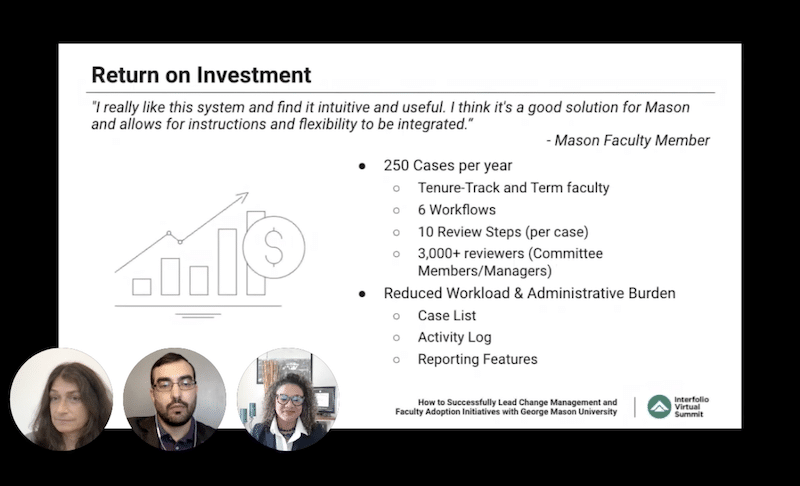
In the panel “Achieving Strategic Goals with a Faculty Information System,” panelists Allysceaeioun D Britt, PhD, MPH of Meharry Medical College, Ed Collom, PhD of California State University-Fullerton, and Alyssa Kupka of DePaul University shared many ways that faculty affairs and administrative workflows at their universities are operating more successfully than ever before.
“Process should dictate the system, not the other way around,” said Dr. Britt. “And Interfolio was able to do that.”
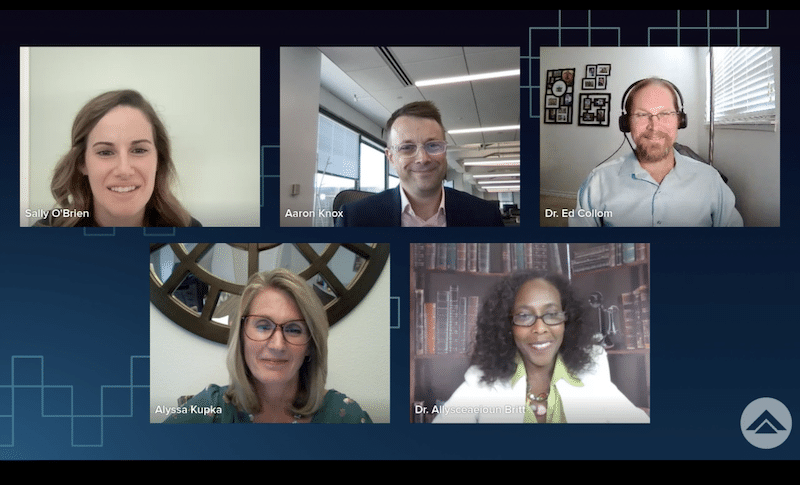
Across this and other Summit panels, we heard how:
- Total time to complete certain reviews had decreased
- Faculty had been “given back” time that they could use to focus on excellent teaching, research, curriculum development, mentoring, community engagement, and other core academic activities
- Professional staff at the university are able to be a greater support than ever to faculty, and are freed up for their own professional growth, by a centralized system really built for this work
- Provost and other administrative offices have been given the space to revisit and reconsider inherited processes
- (Last, but far from least!) Those who already had the faculty-friendly platform in place experienced relative ease of adjustment—and capacity to react—when the COVID-19 pandemic struck
4. Integrations: Faculty Affairs, Interfolio, and the University Technology Ecosystem
Another aspect of this year’s Summit was a focus on how the Interfolio platform, which often reflects the needs of a provost’s or faculty affairs office, can most productively interact with other systems at the institution.
In “Harnessing APIs to Streamline Faculty Hiring with Seamless Integrations,” Georgetown University’s Merced Ada, Rebecca Cpin, Christopher Davis, Emily Fitzgerald, and Charlie Leonhardt broke down how they built an integration between Interfolio Faculty Search for recruitment and their HR system, Workday.
For those focused on integrating with faculty evaluations, J. Reuben Wetherbee of the University of Pennsylvania gave a detailed presentation on three ways that he was able to leverage the Interfolio Review, Promotion & Tenure API to extend the reach (and the time-savings) of the module.
And in a panel focused on Interfolio Faculty Activity Reporting, speakers from Scripps Research Institute, Bowling Green State University, and the Columbia University School of Engineering and Applied Sciences shared how they’ve connected a wide variety of critical campus systems to exchange data with the Interfolio platform.
From faculty data originating in HR and ERP systems, to grants and other financial data, to courses, and even a projected IRB connection, the speakers at these different institutions stressed the value of bringing in data that another unit on campus has already vetted.
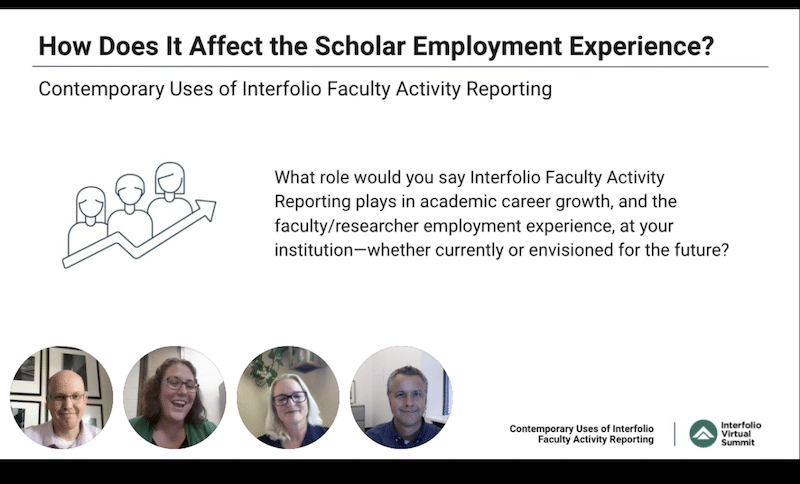
“The depth of reporting [available via Interfolio] has been really important as far as faculty academic career growth—because there’s a lot of support that we can give our faculty when we know more about what they’re doing, their productivity, and where we’re lacking in supporting them.”
Katrina Schreiber, Administrative Manager, Research & Academic Affairs, The Scripps Research Institute5. Successful Change Management: Faculty Affairs Technology is for Real People
Finally, echoing a persistent theme central to the growth and expansion of Interfolio usage worldwide, nearly every client session shared to some extent how they had successfully managed the “human element” of adopting new faculty affairs technology. Namely, that a change in systems really means a change in what people do.
In “How to Successfully Lead Change Management and Faculty Adoption Initiatives,” New York University’s Mike McCaw and George Mason’s Molli J. Herth (mentioned above) generously shared the strategies their institutions had used to systematically bring all needed user groups onboard.
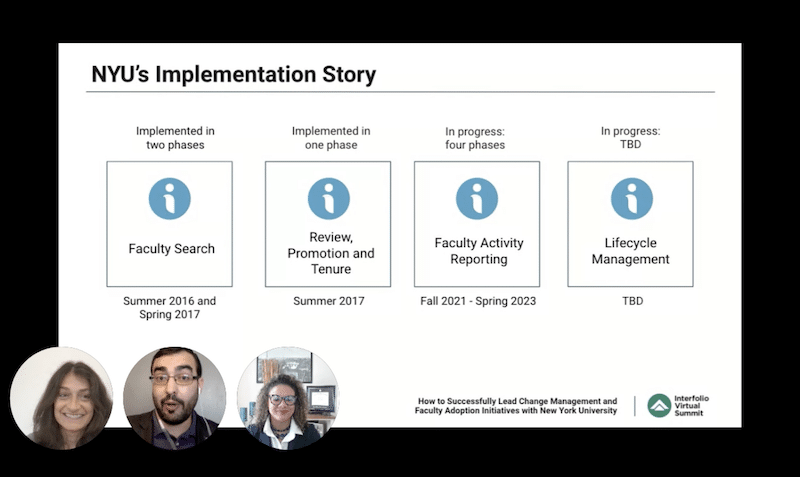
Other speakers from various institutions shared many successful faculty affairs change management choices throughout the Summit, such as:
- Internal workflows of data validation and sign-off from deans, before piping it into the central Interfolio system (“Contemporary Uses of Interfolio Faculty Activity Reporting”)
- Demonstrating security of system access to faculty members (“Achieving Strategic Goals with a Faculty Information System”)
- In some cases, introducing the system with a hybrid model for a year before requiring it—in other cases, making it mandatory institution-wide from the jump (“HBCU Leaders in Conversation”)
- A “train the trainer” model to distribute support for faculty members and others across campus units (“Documenting Personnel Processes and Increasing User Adoption”)
Next Year: August 2022 in Washington, DC!
We are thrilled—and grateful to every contributor and attendee—that the 2021 Summit turned out to be such a lively and welcome hub for faculty affairs dialogue and expertise.
We haven’t even gotten into all of the sessions here, such as those on the ethics of academic data management, the Interfolio product roadmap, the global social purpose of higher education, and others.
But mark your calendars! After two entirely virtual installments in 2020 and 2021, we are proud to announce the 2022 Interfolio Summit will take place in person, August 3-5, in downtown Washington, DC. We look forward to sharing next year what we’ve all learned in between—and to continuing the conversation every day.

